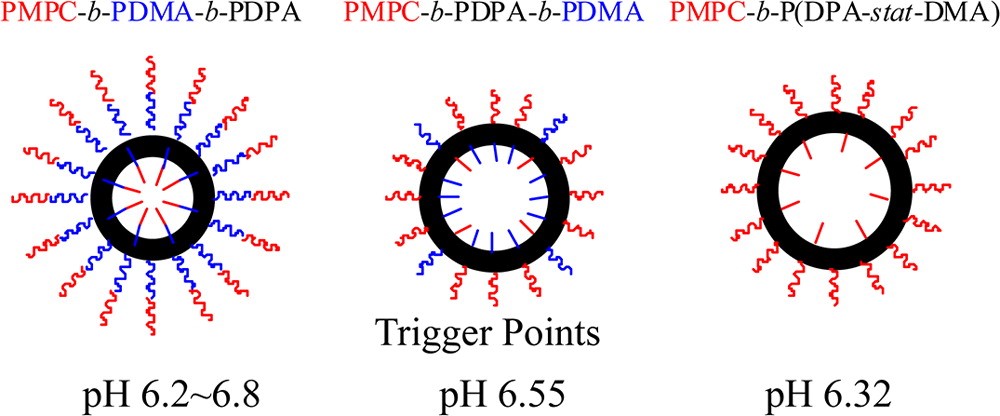pH-Sensitive Block Copolymer Vesicles with Variable Trigger Points for Drug Delivery
作者:Jianzhong Du, Lang Fan, and Qiuming Liu 时间:2012-10-02 点击数:

Abstract
We have previously reported the preparation of a novel pH-sensitive and biocompatible polymer vesicle in pure water based on the spontaneous self-assembly of a diblock copolymer, PMPC-b-PDPA, where PMPC is poly[2-(methacryloyloxy)ethyl phosphorylcholine] and PDPA is poly[2-(diisopropylamino)ethyl methacrylate] ( J. Am. Chem. Soc.2005, 127, 17982). Herein, we intend to report the strategy for controlling the pH trigger points of association/dissociation of pH-responsive polymer vesicles for anticancer drug delivery. We introduced a reactive block, poly[2-(dimethylamino)ethyl methacrylate] (PDMA) into the above diblock copolymer to form reactive PMPC-b-PDMA-b-PDPA and PMPC-b-PDPA-b-PDMA triblock copolymers, as well as PMPC-b-P(DMA-stat-DPA) block-statistical copolymer by atom transfer radical polymerization (ATRP) in methanol at room temperature. As a result of different block length of PDPA, the introduction of PDMA chain at different positions, and different initial copolymer concentrations, those block copolymer vesicles showed tunable pH trigger points and various isoelectric points (IEPs) in aqueous solution. Transmission electron microscopy (TEM) and dynamic light scattering (DLS) studies confirmed that the block copolymers with relatively long PDPA block form polymer vesicles by simply tuning the solution pH in pure water. Above pH 6.2, the PDPA block becomes hydrophobic so it forms the vesicle membrane. In all cases, the hydrophilic PMPC chains form the vesicle coronas. The PDMA chains are designed in three different positions. In PMPC-b-PDMA-b-PDPA vesicles, the PDMA chains form the middle shell between the PDPA vesicle membrane and the PMPC vesicle corona. In PMPC-b-PDPA-b-PDMA vesicles, the PDMA can mix with PMPC to serve as mixed coronas. In PMPC-b-P(DMA-stat-DPA) vesicles, the reactive PDMA chains can be incorporated into the vesicle membrane, which provides an effective strategy regarding the immobilization of vesicles by selective quaternization of PDMA with a bifunctional cross-linker, such as 1,2-bis(2-iodoethoxy)ethane (BIEE). The degree of cross-linking can be tuned by varying the molar ratio of PDMA to BIEE, which was further investigated by 1H NMR, DLS, and TEM, suggesting tunable permeability of vesicle membrane. The triblock copolymer vesicles were able to encapsulate anticancer drugs such as DOX, exhibiting obviously retarded release profile at physiological conditions.
文章链接:Macromolecules 2012, 45, 8275-8283.